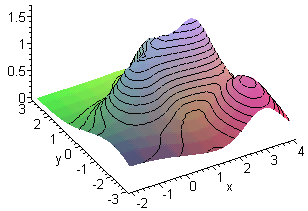Exercises
Sketch the level curves of the following functions at the
given levels.
Find the gradient of the function implied by the level
curve, and then show that it is perpendicular to the tangent line to the
curve at the given point (in 15-17, you will need to use implicit
differentiation to find the slope of the tangent line).
|
|
| | | | |
| | | | |
| | | | |
| | | | |
| | | | |
xcos( x2y) = 2, at ( 2,p) |
|
| | | | |
sin(x2y) = x+1, at ( -1,p) |
|
|
|
|
Find the directional derivative of f in the
direction of the given vector at the given point.
|
|
| |
f( x,y) = x3+y3 at ( 1,1) |
| | | |
f( x,y) = x4+y2 at ( 1,1) |
|
| |
in direction of v =
á 2,1
ñ |
| | | |
indirection of v =
á -3,4
ñ |
|
| |
f( x,y) = cos( xy) at ( p/2,0) |
| | | |
f( x,y) = cos( xy) at ( p/2,0) |
|
| |
in direction of v =
á 1,0
ñ |
| | | |
indirection of v =
á 2,1
ñ |
|
| | | | |
f(x,y) = xsin( xy) at ( p,0) |
|
| |
in direction of v =
á 1,1
ñ |
| | | |
indirection of v =
á 1,-1
ñ |
|
|
|
|
Find the direction of fastest increase of the function at
the given point, and then find the rate of change of the function when it is
changing the fastest at the given point.
|
|
| |
f( x,y) = x3+y3 at ( 1,1) |
| | | |
f( x,y) = x4+y2 at ( 1,1) |
|
| |
f( x,y) = cos( xy) at ( p/2,0) |
| | | |
f( x,y) = cos( xy) at ( p/2,0) |
|
| | | | |
f(x,y) = xsin( xy) at ( p,0) |
|
|
|
|
31. Show that ( 1,2) is a point on the
curve g( x,y) = 2 where g( x,y) = x-2y. Then find
the slope of the tangent line to g( x,y) = 2 in two ways:
- By finding using the gradient to find slope.
- By showing that y = 2x2 and applying the ordinary derivative.
Then sketch the graph of the curve, the tangent line, and the gradient at
that point.
32. Show that ( 3,2) is a point on the
curve g( x,y) = 15 where g( x,y) = x2+xy. Then
find the slope of the tangent line to g( x,y) = 15 in two ways:
- By finding using the gradient to find slope.
- By solving for y and applying the ordinary derivative.
Then sketch the graph of the curve, the tangent line, and the gradient at
that point.
33. Use (1) to determine the level curves
with levels k = 179°F, 217°F, 233°F, and 250°F. Compare your results to the curves in (4).
34. In what direction is the temperature field
|
g( x,y) = 70+180e-( x-3) 2/10-( y-2)2/10 |
|
increasing the fastest at the point ( 1,0) ? At the point ( 0,2) ? Compare your result with the temperatures in (2).
35. Show that the gradient of the temperature function
|
g( x,y) = 70+180e-( x-3) 2/10-( y-2)2/10 |
|
always points toward ( 3,2) . What is the significance of this
result?
36. What is the rate of change of g( x,y)
in (1) at ( 1,1) in the direction of
Why would we expect it to be less than 48. 82°F per inch?
37. A certain "mountain'' shown below, where units are
in thousands of feet:
Use the "mountain" plot above to estimate the levels of each of the
level curves below:
38. In exercise 37, sketch the path of least resistance
from the highest point on the mountain to its base.
39. Write to Learn: Show that the curve r(t) =
á 4cos( t) ,4sin( t)
ñ is a parametrization of f( x,y) = x2+y2
with level 16. Then find T and N at t = p/6. How is
N at t = p/6 related to Ñf at the point ( 2,2Ö3) ? Write a short essay explaining this relationship.
40. *Write to Learn: Obtain a city map and fix a street
corner on that map to be the origin. Define a function f( x,y)
to be the driving distance from that street corner to a point (x,y) , where the driving distance is the shortest possible distance
from the origin to ( x,y) along the roads on the map. What are
the level curves of the driving distance function? Sketch a few of them.
What is the path of least resistance at a given point? Write an essay
describing the f( x,y) function, its level curves, and its
paths of least resistance.
